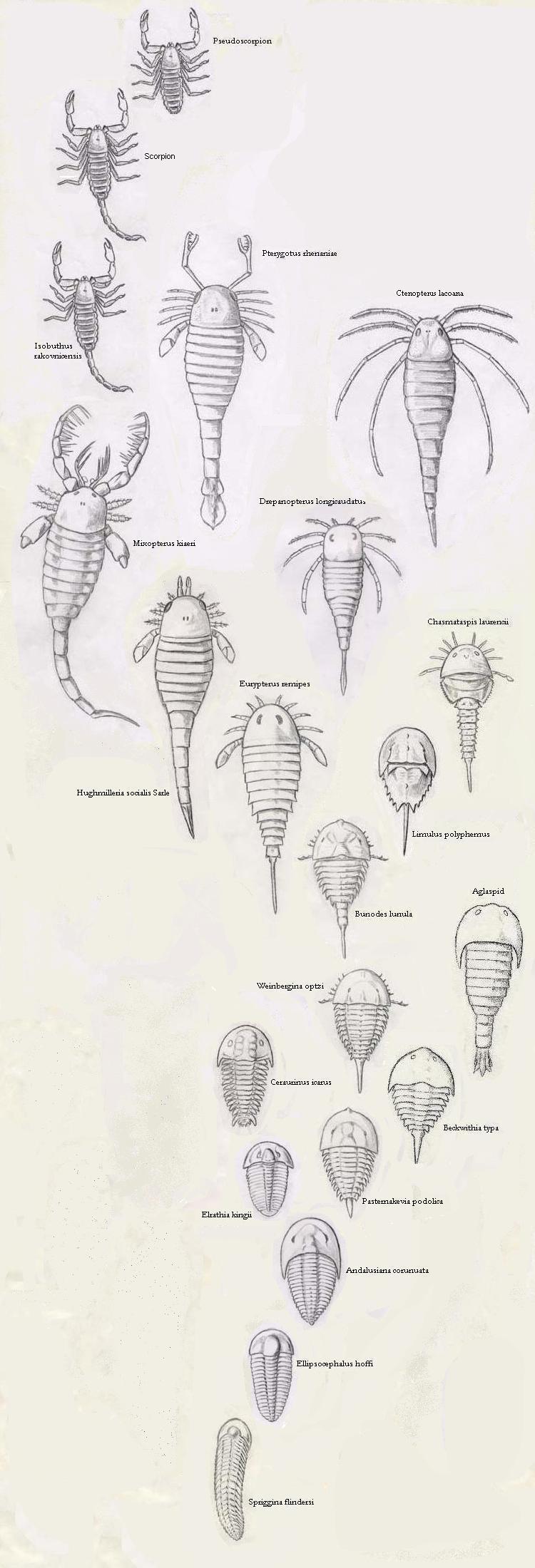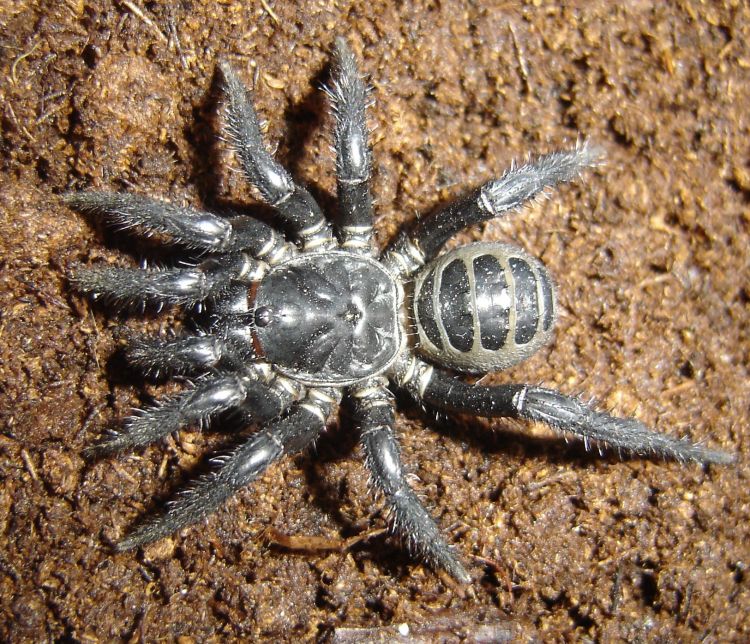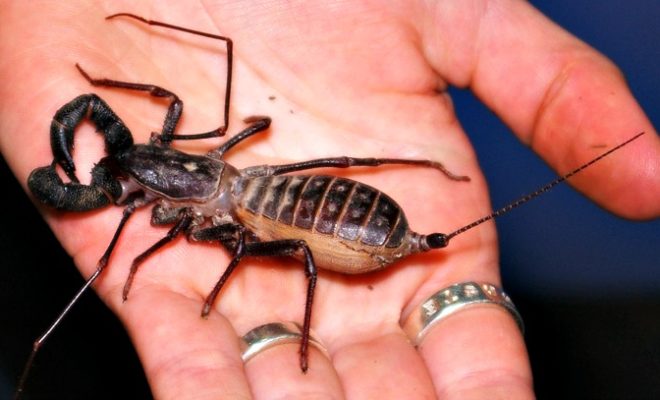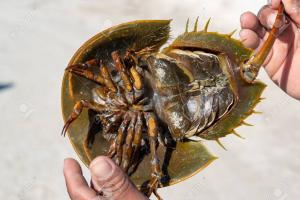I’m involved with the Phylogeny Explorer Project because I’m fascinated by the systematic classification of life-forms. A few days ago, I posted how I and a few paleontologists once thought that turtles weren’t really reptiles; that they might be the last surviving lineage of Permian para-reptiles, but that subsequent discoveries proved us wrong. However years before that, I made another taxonomic prediction, one that went against the status quo, and this time new evidence suggests that I might be right.
A few days ago, someone shared an article saying that a “ground-breaking” genetic study shows that “horseshoe crabs are aquatic spiders“, and “not a crab after all”. But no one really thought they were crabs to begin with, nor horseshoes either. They’re only called that because whoever named them centuries ago thought they looked like both of those things at once. Though I don’t see the resemblance to either one myself.
Once you turn them over, they do look remarkably like spiders wearing armor, except that they have ten legs like crabs. They have ten eyes too, not including the additional photo-receptors on their tails. Yes, they have eyes on their tails!
You have to be careful reading any report about science from the popular press instead of from an actual scientific source. (1) Because the media tends to sensationalize news stories, adding controversy where there is none. (2) Reporters aren’t academic experts and usually don’t really even understand what they’re trying to explain. So they often get important details wrong, causing readers to be mislead. If you don’t want to read, or can’t understand or access the peer-reviewed literature, a more reliably accurate account of this story can be found on Phys.org.
One of the claims that the shared article makes is that horseshoe crabs are “a sister group to Ricinulei, the hooded tick spider”. That certainly reinforces the article’s claim that horseshoe crabs are indeed spiders, being more closely related to one particular family of spiders than to any other. But hooded tick spiders are not spiders. Nor are they ticks. Nor are they even hooded. They are their own separate division of Arachnids, a clade that also includes scorpions, vinegaroons and camel spiders; which aren’t spiders either. Nor are they camels. But camel spiders look more like “hooded tick spiders” than actual spiders do, at least in my opinion. The point is that if scorpions aren’t spiders, then neither are horseshoe crabs, even if they’re both arachnids.
What this new data might do is lend credence to my claim, which no other scientist has yet agreed with. Back in the early aughts, I was studying fossil ‘sea-scorpions’, [Eurypterids] and other Cambrian arthropods with ‘chelicerae’. [tiny crab-like pincers that serve as the mouth parts of scorpions, horseshoe crabs and spiders.] So I was looking at all these fossil chelicerates, taking the ages of each fossil into account, and I noticed a progression of particular traits connecting trilobites, horseshoe crabs and eurypterids to modern arachnids. Below is my sketch of the sequence that I saw in those fossils.

The image above shows an assortment of different chelicerate groups, which appear to me to be all related. When I proposed this evolutionary connection, a few scientists responded with a number of criticisms: (1) They said that the very first species in this list belonged to the wrong clade to be a precursor to trilobites. (2) They said that trilobites aren’t directly-related to either Eurypterids or horseshoe crabs. I was told that the fact that these share the same configuration of so many collective features is merely coincidental or convergent. (3) I was told that eurypterids are only called “sea-scorpions” because they look like scorpions, but that they’re not directly related either; because true scorpions are arachnids, being more similar to spiders. And finally (4) that horseshoe crabs [xiphosurs] aren’t closely-related to anything else in my drawing, because xiphosurs, trilobites, eurypterids and arachnids are all separate clades which were then thought to have evolved side-by-side; even though they show up in fossils sequentially. Well, with the exception of Limulus polyphemus. That is a modern horseshoe crab, one of the last surviving species that is very similar to many fossil species of the same type.
After I drew and shared this image, I’ve learned that the pre-Cambrian Spriggina flindersi at the base of my illustration was never classified with certainty; that it has been tentatively placed in a few different categories by different people, one of them being Arthopoda, which means that it might actually be a precursor of trilobites, just like I thought.
My biggest contention was to say that scorpions and sea scorpions are in fact the same thing. Rather than associating scorpions with spiders, I proposed that scorpions and spiders are both nested within Eurypterida and that each emerged–separately–from within that group; that “arachnids” are in fact a polyphyletic sub-set of Eurypterids.
Here is another illustration to help you understand what eurypterids are.

Not one scientist agreed with me. They said the similarities between eurypterids and scorpions are superficial and the differences too significant. But I say, aren’t modern scorpions even more different from spiders, with which they are currently classed? How different are all the arachnid sub-groups from each other? Especially if you try to include xiphosurs, as this study demands.
By contrast, there are eurypterid fossils that are almost scorpions and some that are almost spiders too. In fact, the link from eurypterids to spiders turns out to be even stronger than the one to scorpions. Just look at ctenopterus. Wouldn’t that almost be a spider if it didn’t have that stinger at the end?
That stinger exists on everything in my drawing, though it isn’t a stinger in most of those cases. It’s called a telson, simply the terminal end of their body segments. Most spiders don’t have segmented bodies anymore. So it’s hard to notice the resemblance. The most primitive clade of spiders alive today is the last remaining family from the sub-order, Mesothelae from eastern Asia. These still have segment plates on their abdomen like scorpions have.

As you can see, this spider looks a lot like a tarantula. It and the tarantula-type spiders [Mygalomorph] have book lungs, like a scorpion does, but every other spider alive today is an Araneomorph that doesn’t share either of those traits. The more primitive spiders don’t have spinnerets either.
Last year, a fossil species (Chimerarachne yingi) was discovered that even had a telson. This find from the Cretaceous matches an even more primitive almost-spider with a similar tail from 290 million years ago.

So it really looks like spiders evolved from something like a scorpion, but obviously not a scorpion. Maybe something like a vinegaroon?

The “whip-tail scorpion” is more like a spider than a scorpion.
Likewise, scorpions must have evolved from something very like a scorpion but that wasn’t a scorpion too. One study even proposed a separate origin for scorpions based on the discovery that eurypterids have book gills of the right type and placement to match the book lungs of scorpions. Thus uniting scorpions and sea scorpions in their own clade separate from spiders.
But if horseshoe crabs are arachnids too, as this genomic study implies, then that could mean that eurypterids are arachnid as well. Because horseshoe crabs are considered to be ‘basal’ [more primitive than, and closely-related, maybe even potentially ancestral] to arachnids and eurypterids both.
We don’t have DNA for eurypterids, because they went extinct so long ago. So until we find the right fossil transitions, we can’t confirm the sort of relationship I’m suggesting. Nor can we now prove that eurypterids are necessarily even a separate group, like we were so certain that xiphosurs were–until this study said otherwise. There would still be several examples of convergence even if I’m right. But the morphological differences between horseshoe crabs and modern arachnids is actually far greater than the differences between any of them and eurypterids, which would be the intermediates in my scheme.
So it seems that I might be right; that spiders and scorpions (as well as other arachnids) arose separately, with one or both of them possibly nested within Eurypterida. Especially since it seems I had this part of the cladogram upside-down. Because eurypterids may be a subset of arachnids; not the other way around.
